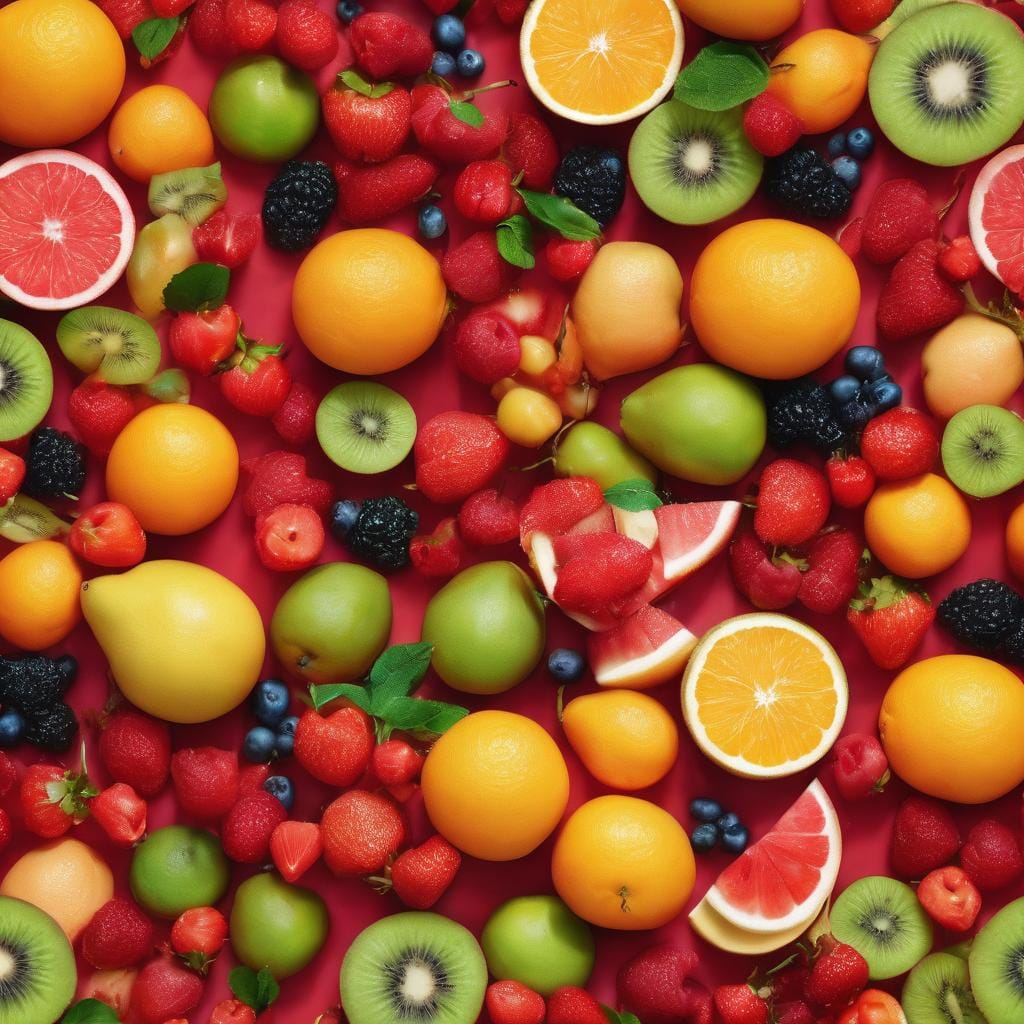Q&A: Does consuming fruit outside of regular meals or during meals enhance its nutritional benefits?
Fruits offer protection against diseases and aiding longevity. Including various fruits, especially whole, enhances nutrient intake, weight control, and blood sugar regulation. Strategic consumption timing can also improve glycaemic response and overall well-being.


This work is licensed under a Creative Commons Attribution-NonCommercial-NoDerivatives 4.0 International License.
Take-home messages
|
Aspect |
With Meals |
Between Meals |
|
Nutritional Impact |
Lowers meal glycaemic load; enhances nutrient
absorption. |
Controls hunger; manages weight and blood sugar
level. |
|
Weight Management |
Increases satiety; replaces high-energy items. |
Reduces calorie intake; aids in weight control. |
|
Blood Sugar |
Moderates blood sugar spikes with balanced meals. |
Provides steady energy; prevents sugar spikes. |
|
Digestive Health |
Aids digestion; promotes gut health with fibre. |
Maintains digestive health; supports gut flora. |
|
Suggested Approach |
Include a variety of fruits in meals. |
Choose whole fruits as snacks over processed
options. |
Introduction
Fruits are a wonderful addition to any diet, offering an array of vitamins, minerals, fibre, and other health-promoting nutrients and phytochemicals (1). Consuming fruits and vegetables, whether together or separately, has been associated with reduced risks of overweight or obesity (2, 3), type 2 diabetes mellitus (4), metabolic syndrome (5), cardiovascular diseases (6), cancer (6), and overall mortality (6). This suggests a significant positive impact of these foods on health and longevity. While consuming fruits is beneficial at any time, there may be additional health advantages related to the timing of fruit consumption.
Beyond Conventional Meal Hours
Consuming fruits outside traditional eating times may provide benefits for controlling weight, regulating blood sugar, and improving digestive health (3, 7-9).
Controlling weight: Reaching for a crisp apple instead of a sugary confection, salty chips, processed pastries, or fried foods is more than just a simple dietary choice; it's a step towards better health and weight management (10). Unhealthy snacks typically offer little nutritional value and are considered "empty calories" that contribute to weight gain without satisfying nutritional needs (1). Opting for solid fresh fruit like apples, rather than apple sauce or apple juice, has been shown to reduce hunger more effectively and delay the onset of the next meal (11). Individuals who snacked on berries showed a reduced energy intake in their subsequent meal compared to those who consumed a confectionery snack, suggesting that berry snacks in the afternoon could help in controlling food consumption and lowering total daily energy intake (8).
Regulating blood sugar: The glycaemic load, a nuanced measure of a food's impact on blood sugar levels, is also worth considering. Fruits contain fructose, a natural sugar that has a lower glycaemic index than glucose, because it is absorbed more slowly and primarily metabolised in the liver (1). This slower absorption and unique metabolic pathway result in a lower and more controlled impact on blood glucose compared to the rapid and direct effects of glucose. Moreover, the fibre-rich matrix of a whole fruit blunts the sugar rush, modulating the body's insulin response and providing a steady stream of energy. Eating high-fibre, low-glycaemic index fruits like berries as a snack can result in lower blood sugar levels compared to consuming high-glycaemic index snacks or no snack at all (9). Eating an apple before a meal is an effective method for controlling blood sugar responses in individuals with impaired glucose tolerance (7). This indicates that the timing of fruit consumption is crucial for people with diabetes, as it can impact blood sugar levels. While fruits are generally beneficial for individuals with diabetes, it's important to note that some have higher glycaemic indices, leading to quicker increases in blood sugar (see Table below). For individuals with diabetes, those in the low glycaemic index category can be consumed more freely, while those in the medium and high glycaemic index categories should be consumed with caution, particularly paying attention to portion sizes and overall meal balance. Thus, strategically timing fruit intake, either with meals or as snacks, can be an effective way to manage blood sugar levels.
|
Low
GI (Consume Freely) |
Glycaemic
Index |
Medium
GI (Consume with Caution) |
Glycaemic
Index |
High
GI (Consume with Caution) |
Glycaemic
Index |
|
Fresh
Whole Fruits |
|||||
|
Cherries |
22 |
Pineapples |
59 |
Watermelon |
76 |
|
Grapefruit |
25 |
Mangoes |
51 |
||
|
Apples |
38 |
Bananas |
51 |
||
|
Pears |
38 |
Kiwi
Fruit |
50 |
||
|
Strawberries |
41 |
Blueberries |
53 |
||
|
Plums |
40 |
Grapes |
49 |
||
|
Raspberries |
32 |
||||
|
Peaches |
42 |
||||
|
Dates
(high in sugar) |
42 |
||||
|
Canned
Fruit |
|||||
|
Canned
Peaches |
30-40 |
|
|
Canned
Fruit Cocktail |
55-65 |
|
Canned
Apricots |
30-40 |
|
|
|
|
|
Fruit
Juices |
|||||
|
Apple
Juice |
41 |
Orange
Juice |
50 |
Pineapple
Juice |
56 |
|
Grapefruit
Juice |
48 |
||||
|
Dried
fruit |
|||||
|
Apricots |
30-32 |
Dates |
42-55 |
Raisins |
64-65 |
|
Prunes |
29-38 |
Apple |
29-44 |
Figs |
61-62 |
|
Peaches |
35-40 |
|
|
|
|
Note that individual responses to specific foods may vary, and factors such as the ripeness of the fruit, and for canned fruits, the type of fruit, the syrup used, and the processing method, can all affect its glycaemic index. A single serving can be a small piece of whole fruit, such as an apple or orange, half a cup of frozen or canned fruit, quarter of a cup of dried fruit or three-quarters of a cup of fruit juice. Please note, dried fruit and fruit juices generally have a higher glycaemic index than whole fresh fruits. It's advisable to ensure that fruit juice makes up less than half of the total fruit consumption – consider having half a glass of juice mixed with soda water. For those with diabetes, it's important to regularly monitor blood sugar levels to understand personal responses to fruit consumption.
Digestive health: Fruits' fibre content not only aids in smooth passage through the gastrointestinal tract but also serves as a prebiotic, fostering a flourishing community of beneficial gut microbes (12). This can be especially relevant for midday snacking when digestive activity is at its peak (13).
Integrating Fruits into Main Meals
Consuming fruits during traditional eating times can play harmoniously with those in other meal components by lowering glycaemic index and aiding absorption. When included as part of a meal or integrated into dishes—such as pairing pineapples, apricots, or dried fruits with low glycaemic indices with cooked meals—the fructose and fibre in fruits can lower the overall glycaemic load of the meal, offering a more gradual release of sugars. The absorption of plant-based iron (non-haeme iron), which is notably enhanced when paired with the vitamin C from fruits—a compelling argument for thoughtful meal composition (1). Vitamin C can be found in oranges, lemons, limes, and grapefruits, strawberries, kiwis, guavas, papayas, blackcurrants, cantaloupes, mangoes, blueberries, and raspberries(1).
Guidelines like the South African Food-Based Dietary Guidelines (SAFBDG) advocate for a daily diet rich in fruits and vegetables (14). The World Health Organisation (WHO) recommends a minimum intake of 400 g of fruits and vegetables per day. This intake is often referred to as "five-a-day," advocating for the consumption of at least five servings of fruits and vegetables each day. These guidelines are based on the evidence of the health benefits provided by a diet rich in fruits and vegetables, for the prevention of chronic diseases such as heart diseases, cancer, diabetes, and obesity, as well as for the prevention and alleviation of several micronutrient deficiencies, especially in less developed countries.
Conclusion
As research on this topic continues to evolve, it's wise to view fruit as advantageous for consumption at any time. The nutritional benefits of fruits remain constant, yet their influence on weight management and nutrient absorption can differ based on the timing of consumption. Many adults(14) and children (15) still fall short of meeting the recommended daily fruit intake. The decision on when to consume fruits, whether one has diabetes or not, is ultimately a personal choice, influenced by individual lifestyle, metabolic factors, and an increasing body of research that underscores the importance of not only what we eat but also when we eat.
Reflections
· Are you meeting the recommended daily fruit intake?
· What changes can you make to ensure you meet or exceed these guidelines?
· How might adjusting the timing of your fruit intake impact your overall health, especially if you have specific goals like weight management, blood sugar regulation, improving digestive health or nutrient absorption?
Love what you’re reading? Share the knowledge! 📨 Forward this link to a friend who might also enjoy it.
References
1. Whitney EN, Rolfes SR, Crowe T, Walsh A. Understanding nutrition: Cengage AU; 2019.
2. Schwingshackl L, Hoffmann G, Kalle-Uhlmann T, Arregui M, Buijsse B, Boeing H. Fruit and vegetable consumption and changes in anthropometric variables in adult populations: a systematic review and meta-analysis of prospective cohort studies. PloS one. 2015;10(10):e0140846. https://journals.plos.org/plosone/article/file?id=10.1371/journal.pone.0140846&type=printable
3. Rolls BJ, Ello-Martin JA, Tohill BC. What can intervention studies tell us about the relationship between fruit and vegetable consumption and weight management? Nutrition reviews. 2004;62(1):1-17. https://academic.oup.com/nutritionreviews/article/62/1/1/1913551?login=true
4. Guo X-f, Yang B, Tang J, Jiang J-J, Li D. Apple and pear consumption and type 2 diabetes mellitus risk: a meta-analysis of prospective cohort studies. Food & function. 2017;8(3):927-34. https://pubs.rsc.org/en/content/articlehtml/2017/fo/c6fo01378c
5. Lee M, Lim M, Kim J. Fruit and vegetable consumption and the metabolic syndrome: a systematic review and dose–response meta-analysis. British Journal of Nutrition. 2019;122(7):723-33. https://www.cambridge.org/core/journals/british-journal-of-nutrition/article/fruit-and-vegetable-consumption-and-the-metabolic-syndrome-a-systematic-review-and-doseresponse-metaanalysis/4B60CAADCFFDF291DBF756F18798CE31
6. Aune D, Giovannucci E, Boffetta P, Fadnes LT, Keum N, Norat T, et al. Fruit and vegetable intake and the risk of cardiovascular disease, total cancer and all-cause mortality—a systematic review and dose-response meta-analysis of prospective studies. International journal of epidemiology. 2017;46(3):1029-56. https://academic.oup.com/ije/article/46/3/1029/3039477
7. Inoue Y, Cormanes L, Yoshimura K, Sano A, Hori Y, Suzuki R, et al. Effect of apple consumption on postprandial blood glucose levels in normal glucose tolerance people versus those with impaired glucose tolerance. Foods. 2022;11(12):1803. https://www.mdpi.com/2304-8158/11/12/1803
8. James LJ, Funnell MP, Milner S. An afternoon snack of berries reduces subsequent energy intake compared to an isoenergetic confectionary snack. Appetite. 2015;95:132-7. https://www.sciencedirect.com/science/article/abs/pii/S0195666315003220
9. Jenkins D, Srichaikul K, Kendall C, Sievenpiper J, Abdulnour S, Mirrahimi A, et al. The relation of low glycaemic index fruit consumption to glycaemic control and risk factors for coronary heart disease in type 2 diabetes. Diabetologia. 2011;54:271-9. https://link.springer.com/article/10.1007/s00125-010-1927-1
10. Elfhag K, Tholin S, Rasmussen F. Consumption of fruit, vegetables, sweets and soft drinks are associated with psychological dimensions of eating behaviour in parents and their 12-year-old children. Public Health Nutr. 2008;11(9):914-23. https://www.cambridge.org/core/journals/public-health-nutrition/article/consumption-of-fruit-vegetables-sweets-and-soft-drinks-are-associated-with-psychological-dimensions-of-eating-behaviour-in-parents-and-their-12yearold-children/8AC17EAF4E7633B2EAB6F6F9DC45F5D5
11. Mattes RD, Campbell WW. Effects of food form and timing of ingestion on appetite and energy intake in lean young adults and in young adults with obesity. Journal of the American Dietetic Association. 2009;109(3):430-7. https://europepmc.org/article/pmc/pmc2680008
12. Katsirma Z, Dimidi E, Rodriguez-Mateos A, Whelan K. Fruits and their impact on the gut microbiota, gut motility and constipation. Food & Function. 2021;12(19):8850-66. https://pubs.rsc.org/en/content/articlelanding/2021/fo/d1fo01125a
13. Bron R, Furness JB. Rhythm of digestion: keeping time in the gastrointestinal tract. Clinical and Experimental Pharmacology and Physiology. 2009;36(10):1041-8. https://onlinelibrary.wiley.com/doi/abs/10.1111/j.1440-1681.2009.05254.x?casa_token=MgW_gukobHAAAAAA%3AVm0cdsDH04ptVpo698v4WK08ukd5BaXJKmKg7KR2LE9k3rwY9oOhq-b4xMsnMMU8RfSB_z7TyVfp8g
14. Naudé CE. “Eat plenty of vegetables and fruit every day”: a food-based dietary guideline for South Africa. South African journal of clinical nutrition. 2013;26:S46-S56. https://www.ajol.info/index.php/sajcn/article/view/97801
15. Vik FN, Heslien KE, Van Lippevelde W, Øverby NC. Effect of a free healthy school meal on fruit, vegetables and unhealthy snacks intake in Norwegian 10-to 12-year-old children. BMC Public Health. 2020;20:1-8. https://link.springer.com/article/10.1186/s12889-020-09470-2
In the process of creating this work, the author employed ChatGPT 4 to streamline the text and to perform language editing.




